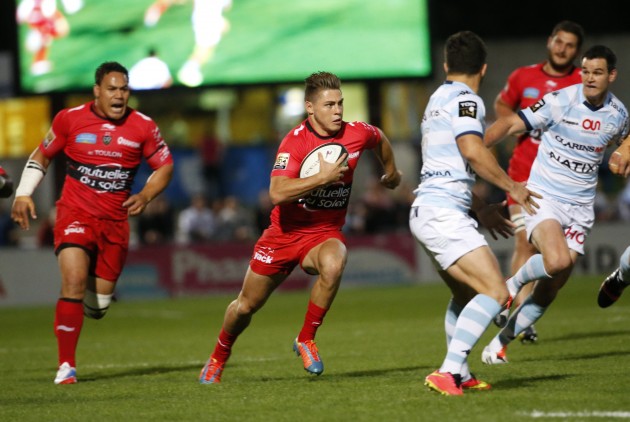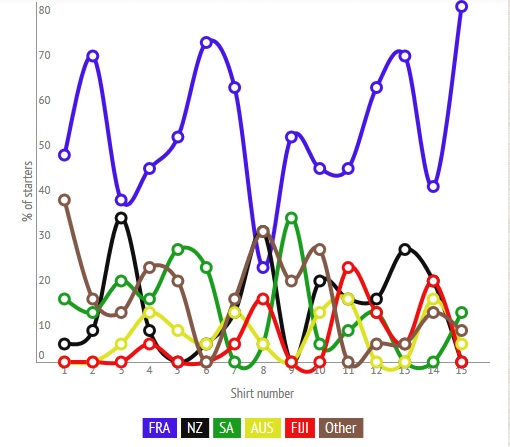In his first stats-based piece, Russ Petty looks at the breakdown of personnel in the multi-national Top 14...
Last season’s Top 14 was fiercely contested with just a 16-point gap separating top side Toulon and Brive in ninth place. As a comparison, the difference between first and ninth place was 43 points in the Aviva Premiership and 47 points in the Guinness Pro12. A notable change in attitude towards away fixtures is a factor in the increased competitiveness in the French league, but perhaps more significant is the composition and similarity of the squads. Are the collective owners following the same blueprint for assembling a ‘perfect’ team?
It may not be a huge surprise that the majority of imports to France are (in order) from South Africa, New Zealand, Fiji, Australia, Tonga, Georgia, and Samoa. Of greater interest is the clear pattern of recruiting each nation’s iconic or traditionally strong position(s), as can be seen below.
[Factors such as JIFF, Kolpak ruling, player eligibility / nationality means such a list can only be used as a rough squad guide rather than treated as fully accurate, as an example: Clermont prop Daniel Kötze, born in South Africa but now capped for France]
Georgia on my bind
Rampaging flanker Mamuka ‘Gorgodzilla’ Gorgodze might take the headlines, but The Lelos are better associated with churning out a seemingly endless supply of destructive scrummagers from the prop factories in Tbilisi. The sides without one of these (usually) bearded behemoths are in the minority and an average of four Georgian props start in each round.
Bok brains and brawn
In a league oft characterised as set piece orientated, it makes sense to head to South Africa for aggressive enforcers and lineout technicians in the engine room. With the likes of Juandré Kruger and Bakkies Botha are winning ball in the air or throwing their weight around, there has also been an increase in the number of South African scrum-halves brought in to manage the game, with an average of 4 starters each round this year.

Brain power: Castres’ South Africa-born scrum-half Rory Kockott bossing play
Backing Black
New Zealand is well represented at prop, No 8, fly-half, centre and wing and an explanation for that variety would be the different heritages involved. As an example: powerful No 8 Alex Tulou who was born in American Samoa or prop Saimone Taumoepeau from Tonga.
Bayonne bruiser Charles Ollivon stood out in the first round not just for his strong carrying but also his status as a French qualified No 8, seemingly an endangered species, with an average of just 5 starting per round last season. Only he and (Durban-born) Antonie Claassen made starting line-ups in the first week, compared to Lee, Grice, Clarkin, Whetton and Tulou from New Zealand. Along with the dominant back-row ball-carriers and tighthead props, midfield guile is also a sought after commodity with an average of five Kiwi centres appearing each round.
Fijian firepower
Having overpowered an opponent up front or unlocked their defence, a finisher is still required and that role is increasingly being given to a Fijian flyer. Lethal pace and ability to beat defenders also means a defensively minded side can chose to sit back and strike on the counter. Only 34 of the 81 tries scored so far this season were by French players and there has been a steady decline in French representation in the top ten try scorers each year, with just Sofiane Guitoune making the list last season. In contrast, Fijians Talebula, Nagusa, Nayacalevu and Nalaga all managed eight or more tries. With Brive seeking to gain an advantage in the recruitment arms race by opening an academy in Nadi, Fiji, Noa Nakaitaci is unlikely to be the last example of a French convert.
Effect on Les Bleus?
In Confessions of a Rugby Mercenary, John Daniell described top level rugby as: “not really a choice between the rapier and the cudgel: everyone has a cudgel, so you better have one too, and the bigger the better. But you would be well-advised to have a rapier as well, and to know how to handle it”.
When France coach Philippe Saint-André checks the Top 14 armoury, he may find those weapons aren’t all available for his selection.
Breakdown of starters by nationality for rounds one and two of current Top 14 season
Mention in the French media of Uini Atonio and Rory Kockott being called up is interesting when it is considered that New Zealand tightheads and South African scrum-halves have been used regularly in the opening rounds this season.
While hooker, flanker, centre and full-back appear to be positions of depth for France (in quantity at least), an under pressure and usually pragmatic Saint-André may opt to follow the blueprint used by his Top 14 colleagues for other positions. With an absence of traditional French flair, the next time we see another ‘try from the end of the world’ it may be created and scored by those from around the world.







